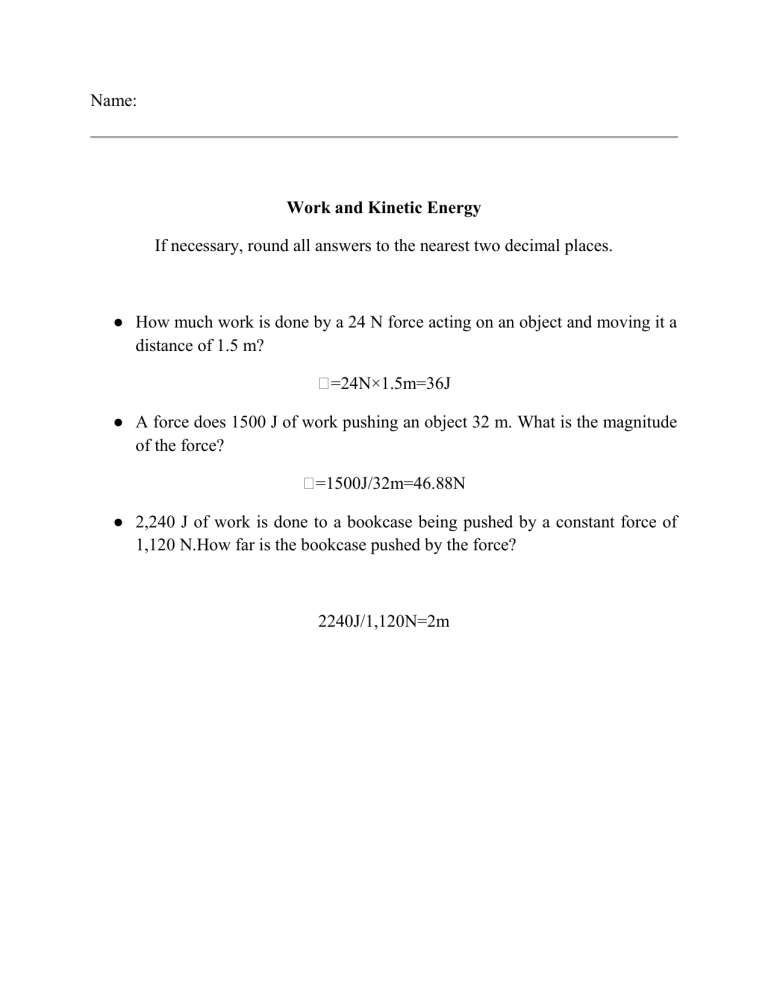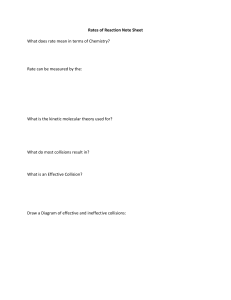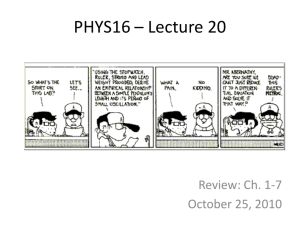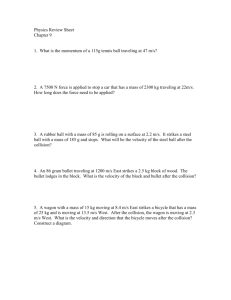
Name: Work and Kinetic Energy If necessary, round all answers to the nearest two decimal places. ● How much work is done by a 24 N force acting on an object and moving it a distance of 1.5 m? �=24N×1.5m=36J ● A force does 1500 J of work pushing an object 32 m. What is the magnitude of the force? �=1500J/32m=46.88N ● 2,240 J of work is done to a bookcase being pushed by a constant force of 1,120 N.How far is the bookcase pushed by the force? 2240J/1,120N=2m ● Let us consider an object with a mass, �, of 4 kg and an initial velocity, �, of zero. The initial kinetic energy of the object is zero. A constant force of 2 N acts on the object to increase its velocity to a final value, �, of 15 m/s. The kinetic energy of the object at its final velocity is given. a) Find 𝐾𝐾 450 J=½*4kg*(15m/sec)^2 b) Find acceleration a=F/kg a=.5𝐾/𝐾𝐾𝐾2 c) Find displacement s (Distance) �^2=�^2+2�� 152 = 0 + (2 ∗ .5 ∗ 𝐾) 225=s s=225m d) Find the work done on the system W=450J ● Consider the graph below 1. What work is done to the object over the first 5 m that the object moves? a) determine the average force F=50N b) Use the average force to determine the work done W=250J 2. What work is done to the object when moving from 0 m to 8 m away from the position of the object when the force was initially applied? W=5100J ● An average force of 8 250 N is applied by a car’s wheels while the car moves a distance of 850 m. The car’s engine does 15 megajoules of work altogether. How much work, in megajoules, was done that did not involve moving the car, such as moving the air around the car, moving parts of the road surface, and heating parts of the car? 𝐾𝐾ℎ𝐾𝐾𝐾 = 8,250𝐾 ∗ 850𝐾 = 7,012,500𝐾 𝐾𝐾 ≈ 7.01𝐾𝐾 𝐾𝐾𝐾𝐾𝐾 = 𝐾𝐾𝐾𝐾𝐾𝐾 − 𝐾𝐾ℎ𝐾𝐾𝐾 𝐾𝐾𝐾𝐾𝐾 = 15𝐾𝐾 − 7.01𝐾𝐾 𝐾𝐾𝐾𝐾𝐾 = 7.99𝐾𝐾 Ener gy ● A ball bounces repeatedly, dissipating 10% of its kinetic energy with each bounce. Li n Li e n A Li e n B e C Time Which of the lines plotted on the graph correctly represents the change in the mechanical energy of the ball with time? ● Two objects, I and II, collide. Object I has a mass of 20 kg and object II has a mass of 60 kg. Object I has a speed of 18 m/s before the collision, and object II has a speed of 13 m/s before the collision. The collision is inelastic, ● If object I is stationary after the collision, what is the speed of object II after the collision? 14.41 𝐾 𝐾𝐾𝐾 If object II is stationary after the collision, what is the speed of object I after the collision? 24.96 𝐾 𝐾𝐾𝐾 If both objects have the same speed after the collision, what is their speed? 12.48 𝐾 𝐾𝐾𝐾 ● Two objects, I and II, collide. Object I has a mass of 0.75 kg and object II has a mass of 0.45 kg. Object I has a speed of 2.8 m/s before the collision and object II has a speed of 3.3 m/s before the collision. The collision is inelastic, dissipating 35% of the kinetic energy of the objects. After the collision, object I has a speed of 1.8 m/s. What is the total Kinetic Energy before the collision? 5.39J What is the Kinetic Energy of object II after the collision? .26J What is the speed of object II after the collision? .57 𝐾 𝐾𝐾𝐾 What is the ratio of the kinetic energy of object I before the collision to its kinetic energy after the collision? 110.20% or 54/49 What is the ratio of the kinetic energy of object II before the collision to its kinetic energy after the collision? 10.61% Momentum If necessary, round all answers to the nearest two decimal places. ● A cricket ball of mass 160 g has a constant velocity of 15 m/s. A golf ball of mass 40 g has the same velocity as the cricket ball. What velocity change must the cricket ball undergo to have the same momentum as the golf ball? -11.25𝐾 𝐾 𝐾𝐾𝐾 ● How many times greater is the momentum of a 1,500 kg mass hippo moving at 0.325 m/s than a 75 g mass bird flying at 10 m/s? 𝐾 650𝐾 𝐾𝐾𝐾 ● What is the mass of an object that moves at a constant velocity of 3.3 m/s if its momentum is 4.4 kg⋅ m/s? 1.33 kg ● A bag of mass 1.5 kg is being carried horizontally at a velocity of 1.2 m/s when it opens and 0.25 kg of its contents spill out vertically. The person holding the bag does not immediately notice what has happened and, for a short time, they continue to move horizontally at the same speed. What is the horizontal momentum of the bag after it opens and the contents are spilled? 1.5kg 𝐾 𝐾𝐾𝐾 What is the horizontal momentum of the spilled contents? 0.3𝐾𝐾 𝐾 𝐾𝐾𝐾 ● An average force of 15 N is applied by moving air to a bicycle and its rider, of total mass 80 kg, while it is windy that day. The force is applied throughout a time interval of 0.9 s as the gust of wind is very brief. The wind blows from directly behind the bicycle. What is the total momentum change? 13.5𝐾𝐾 𝐾 𝐾𝐾𝐾 ● A man running on a road had a momentum of 366 kg⋅ m/s.The road ahead of the man was covered by sand. The man ran through the sand for 12 seconds and his momentum when he had crossed the sand-covered part of the road was 330 kg⋅ m/s.What average force did the sand apply to the man while he ran across it? -3𝐾𝐾 𝐾 𝐾𝐾𝐾 ● During a game of pool, a cue ball that has a mass of 170 g moves along a pool table at a constant speed of 80 cm/s.The cue ball hits another ball, which has a mass of 169 g and is not moving, as shown in the diagram. After the collision, the cue ball does not move. What constant speed, in centimeters per second, does the 169 g mass ball move at after the collision? 80cm/s 169g 170 g 𝐾𝐾 80.47 𝐾 (Extra credit 5 points) ● A bullet with a mass of 10 g is traveling at 475 m/s and hits a stationary toy car of mass 300 g. The bullet comes to rest 0.01 s after hitting the car. What force is required to bring the bullet to rest in 0.01 s? -475N What is the acceleration of the car due to the impact of the bullet? 1,583.33 𝐾 𝐾𝐾𝐾 2




